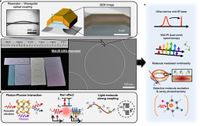A breakthrough in on-chip photonics has been achieved with the development of ultra-high-Q microresonators at mid-infrared (mid-IR) wavelengths, paving the way for advanced molecular sensing technologies. Researchers have created on-chip microresonators with an unprecedented Q-factor of 38 million at a wavelength of 3.86 μm, surpassing previous records by more than 30 times. This achieving signifies a major advancement in the quest for efficient, compact optical devices capable of operating at longer wavelengths, crucial for applications in molecule science such as monitoring molecular vibrations and enhancing biochemical imaging techniques.
Traditionally, the advancement of ultra-high-Q resonators has primarily focused on the near-infrared region; however, the challenge remains in transitioning to the mid-infrared wavelengths, where many molecules exhibit significant absorption characteristics. The recent innovations include innovative fabrication techniques that spontaneously create light-guiding geometries with internal multilayer structures during material deposition. These advancements enabled the mitigation of major loss factors, such as airborne-chemical absorption, significantly hampering on-chip device performance.
The researchers utilized chalcogenide glass (ChG) for the microresonators, capitalizing on its wide transmission spectrum and substantial nonlinear optical properties. They incorporated a bottom cladding layer of ChG to combat excessive material losses in conventional platforms typically utilized in the mid-IR spectrum. This strategy proved effective, as the intrinsic Q-factor achieved was 3.81 x 107.
Additionally, the study showcased stimulated Brillouin lasing in the mid-infrared, a significant milestone in this field, achieved with a remarkably low threshold power of just 91.9 μW and an impressive Schawlow-Townes linewidth of 83.5 Hz. These results not only demonstrate the practical implementation of high-quality on-chip devices, but also highlight the potential to realize various functionalities previously constrained to bulky optical setups.
The innovative fabrication process outlined in the study eliminated the need for traditional subtractive techniques, utilizing directionally deposited chalcogenide materials to form smooth geometries without rough edges that can cause high scattering losses. This approach led to a profound reduction in surface-adsorbed airborne molecule absorption, a prominent contributing factor to losses in on-chip devices operating in the mid-IR region.
To further enhance performance, a 10 nm thick Ge-As-Se film was assessed as a passivation layer, demonstrating commendable resistance to various environmental factors while maintaining low optical losses. The extensive analyses conducted within the framework of this study offer valuable insights into how optical losses can be decreased to approach those of state-of-the-art ChG fibers, which previously set the standard in low-loss mid-IR photonic performance.
The implications of this research extend far beyond the findings presented. A competitive propagation loss of 0.52 dB/m has been achieved, indicating that this technology can effectively compete with fiber-based systems while facilitating ultra-narrow linewidth lasers. Future avenues of research may focus on developing various integrated optical functions utilizing these ultra-high-Q resonators, thus promising a strong impact on fundamental research topics such as molecule-induced nonlinear optics.
In conclusion, the successful realization of mid-infrared microresonators with exceptional Q-factors represents a significant leap for integrated photonics. This breakthrough, attained through a meticulous design and fabrication approach addressing critical loss mechanisms, sets the stage for more applications in molecular spectroscopy, biochemical imaging, and environmental monitoring with on-chip optical devices.




